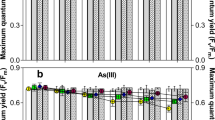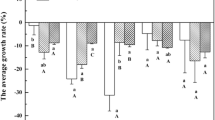Abstract
This study examines the accumulation of 74As-arsenic in the seaweeds Fucus spiralis (L.) and Ascophyllum nodosum (L.) collected from Restronguet Creek in southwest England during 1978. Also, the influence of environmental factors (valence state of arsenic, pH, salinity, temperature, phosphate concentration) and metabolic inhibitors on the uptake of arsenic by F. spiralis is examined. Most of the arsenic in the seaweeds was non-exchangeable with labelled arsenic in the medium. The accumulation of 74As reached a steady state in 1 to 8 d, depending on the species and external arsenic concentration. At steady state the accumulated arsenic is proportional to external arsenate concentration. F. spiralis accumulated 4 times more arsenate than arsenite. The short-term uptake of arsenic increased in proportion to the external arsenic concentration up to a level of 1000 μg l-1; it then remained constant at higher levels of arsenic. Arsenic uptake increased in direct proportion to increasing temperature. Variation of pH or salinity had no effect on arsenic incorporation. The accumulation of arsenic occurred only in living tissue and was inhibited by KCN in a concentration-dependent manner. The uptake of arsenic by F. spiralis in the presence of photo-synthetic inhibitors (DCMU or CMU) or in the dark was greater than in the light controls. Thus, it was concluded that energy is required for arsenic uptake and this is derived from respiration rather than photosynthesis. There was no evidence for a common mechanism of phosphate and arsenate uptake by macroalgae, although high concentrations of phosphate (40 to 400 μM) initially inhibited arsenate uptake.
Similar content being viewed by others
Literature Cited
Andreae, M. O. and D. W. Klumpp: Biosynthesis and release of organoarsenic compounds by marine algae. Envir. Sci. Technol. 13, 738–741 (1979)
Atkins, W. R. G.: The phosphate content of seawater in relation to the growth of the algal plankton, Part III. J. mar. biol. Ass. U.K. 14, 447–467 (1926)
Ball, R. C. and F. H. Hooper: The use of As74-tagged sodium arsenite in a study of effects of a herbicide on pond ecology. In: Isotopes in weed research, pp 146–163. Vienna: International Atomic Energy Agency 1966
Blasco, F.: Reduction partielle de l'arsénate en arsénite et exsorption de l'arsenic par Chlorella pyrenoidosa. Physiologie veg. 13, 185–201 (1975)
Blum, J. J.: Phosphate uptake by phosphate-starved Euglena. J. gen. Physiol. 49, 1125–1137 (1966)
Borst Pauwels, G. W. F., J. K. Peter, S. Jager and C. C. B. Wijffels: A study of the arsenate uptake by yeast cells compared with phosphate uptake. Biochim. biophys. Acta 94, 312–314 (1965)
Bottino, N. R., R. D. Newman, E. R. Cox, R. Stockton, M. Hoban, R. A. Zingaro and K. J. Irgolic: The effects of arsentate and arsenite on the growth and morphology of the marine unicellular algae Tetraselmis chui (Chlorophyta) and Hymenomonas carterae (Chrysophyta). J. exp. mar. Biol. Ecol. 33, 153–168 (1978)
Bryan, G. W.: The absorption of zinc and other metals by the brown seaweed Laminaria digitata. J. mar. biol. Ass. U.K. 49, 225–243 (1969)
Bryan, G. W.: The effects of heavy metals (other than mercury) on marine and estuarine organisms. Proc. R. Soc. (Ser. B) 177, 389–410 (1971)
Bryan, G. W. and L. G. Hummerstone: Brown seaweed as an indicator of heavy metals in estuaries in south-west England. J. mar. biol. Ass. U.K. 53, 705–720 (1973)
Button, D. K., S. S. Dunker and M. L. Morse: Continuous culture of Rhodotorula rubra: kinetics of phosphate-arsenate uptake, inhibition and phosphate-limited growth. J. Bact. 113, 599–611 (1973)
Chambers, E. L. and A. H. Whiteley: Phosphate transport in fertilized sea urchin eggs. I. Kinetic aspects. J. cell Physiol. 68, 289–308 (1966)
Chipman, W. A., T. R. Rice and T. J. Price: Uptake and accumulation of radioactive zinc by marine plankton, fish and shellfish. Fishery Bull. Fish Wildl. Serv. U.S. 58, 279–292 (1958)
Gutknecht, J.: Mechanism of radioactive zinc uptake by Ulvalactuca. Limnol. Oceanogr. 6, 426–431 (1961)
Gutknecht, J.: Uptake and retention of cesium-137 and zinc-65 by seaweeds. Limnol. Oceanogr. 10, 58–66 (1965)
Harvey, H. W.: Recent advances in the chemistry and biology of sea water, 164 pp. Cambridge University Press 1945
Irgolic, K. J., E. A. Woolson, R. A. Stockton, R. D. Newman, N. R. Bottino, R. A. Zingaro, P. C. Kearney, R. A. Pyles, S. Maeda, W. J. McShane and E. R. Cox: Characterization of arsenic compounds formed by Daphnia magna and Tetraselmis chuii from inorganic arsenate. Envir. Hlth Perspectives 19, 61–66 (1977)
Jung, C. and A. Rothstein: Arsenate uptake and release in relation to the inhibition of transport and glycolysis in yeast. Biochem. Pharmac. 14, 1093–1112 (1965)
Klumpp, D. W.: Arsenic accumulation in an estuarine food chain, 269 pp. Ph.D. thesis, University of London, London 1979
Klumpp, D. W.: Arsenic metabolism in an estuarine food chain. (In preparation)
Klumpp, D. W. and P. J. Peterson: Arsenic and other trace elements in the waters and organisms of an estuary in S.W. England. Envir. Pollut. 19, 11–20 (1979)
Kuenzler, E. J. and B. H. Ketchum: Rate of phosphorus uptake by Phaeodactylum tricornutum. Biol. Bull. mar. biol. Lab., Woods Hole 123, 134–146 (1962)
Lunde, G.: Analysis of arsenic and selenium in marine raw materials. J. Sci. Fd Agric. 21, 242–247 (1970)
Lunde, G.: The absorption and metabolism of arsenic in fish. Rep. technol. Res. Norw. Fish Ind. 5 (12), 1–15 (1972)
Lunde, G.: The synthesis of fat and water-soluble arseno-organic compounds in marine and limnetic algae. Acta chem. scand. 27, 1586–1594 (1973)
McKenzie, H. A.: pH and buffers. In: Data for biochemical research, pp 475–508. Ed. by R. M. C. Dawson. Oxford: Clarendon Press 1969
Onishi, H.: Arsenic. In: Handbook of geochemistry, Vol. 2(3). pp 33-B-1–33-0-1. Ed. by K. H. Wedepohl. Berlin: Springer-Verlag 1969
Penrose, W. R.: Biosynthesis of organic arsenic compounds in brown trout (Salmo trutta). J. Fish. Res. Bd Can. 32, 2385–2390 (1975)
Penrose, W. R., H. B. Conacher, R. Black, J. C. Meranger, W. Miles, H. M. Cunningham and W. R. Squires: Implications of inorganic/organic interconversions on fluxes of arsenic in marine food webs. Envir. Hlth Perspectives 19, 53–59 (1977)
Pentreath, R. J.: Radiobiological studies with marine fish. In: Design of radiotracer experiments in marine biological systems. Int. atom. Energy Ag. tech. Rep. Ser. 167, 137–170 (1975)
Raymont, J. E.: Plankton and productivity in the oceans, 660 pp. Oxford: Pergamon Press 1963
Reay, P. F. and C. J. Asher: Preparation and purification of As74-labelled arsenate and arsenite for use in biological experiments. Analyt. Biochem. 78, 557–560 (1977)
Rice, T. R.: The accumulation and exchange of strontium by marine planktonic algae. Limnol. Oceanogr. 1, 123–138 (1956)
Rothstein, A.: Interactions of arsenate with the phosphate transporting system of yeast. J. gen. Physiol. 46, 1075–1085 (1963)
Author information
Authors and Affiliations
Additional information
Communicated by G. F. Humphrey, Sydney
Rights and permissions
About this article
Cite this article
Klumpp, D.W. Characteristics of arsenic accumulation by the seaweeds Fucus spiralis and Ascophyllum nodosum . Marine Biology 58, 257–264 (1980). https://doi.org/10.1007/BF00390774
Accepted:
Issue Date:
DOI: https://doi.org/10.1007/BF00390774




